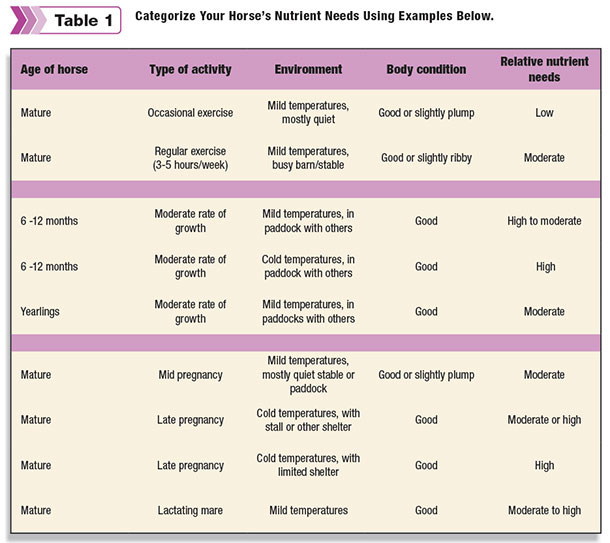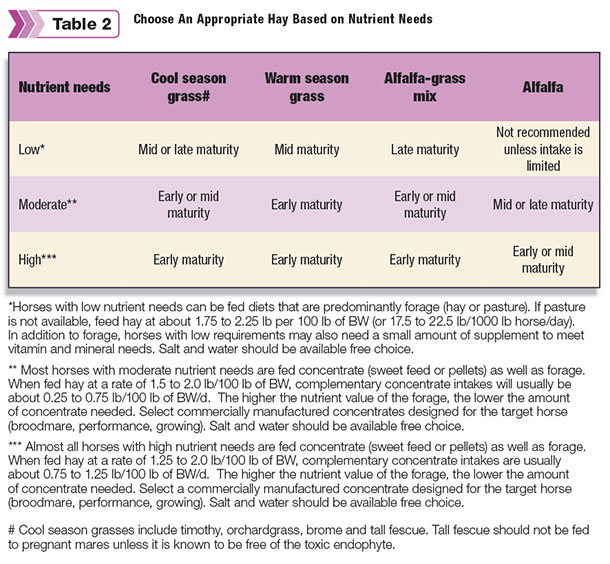But hay is not just filler. Hay is an important source of nutrients, and for many mature, non-breeding horses, hay can provide the majority of nutrition the horse needs.
What is hay quality?
There are two ways to look at hay quality: One relates to the physical characteristics of the hay, and the other relates to the nutrient content.
Physical characteristics: Cleanliness
Clean hay is free from dust, mold, trash and weeds. Hay that is dusty or moldy can irritate the respiratory tract and affect exercise ability.
Hay that looks good on the outside can still have mold in the center, so it is important to examine each bale when you open it. Hay with weeds or other contaminants is also undesirable.
Nutritional characteristics: Stage of maturity and hay type
As a plant grows, its structure changes, and its chemical composition also changes. In an early stage of maturity, plants are leafy.
As they mature, plants develop larger stems, flowers and seed heads. If you see large seed heads and thick stems in hay, it means it was harvested at a late stage of maturity.
The leaves contain more digestible nutrients than the stems.
Plants cut in early maturity, when they are leafy, are higher in nutrients than plants cut in late maturity, when they are stemmy. Stage of maturity is not the same as “cutting.”
The term “cutting” is used to designate how many times the field has been harvested in a given year. The first harvest from a hayfield is called the first cutting, the second harvest is the second cutting, and so on.
Overall, stage of maturity has a bigger effect on nutrient value than cutting.
Many different types of hay are acceptable to horses. The varieties of hay that can be grown in a particular area will depend on climate and soil conditions.
Warm-season grasses such as bermudagrass are popular in southern regions, while cool-season grasses (timothy, orchardgrass, brome) are popular in cooler climates.
Alfalfa is a legume that is grown in many areas, and it may be grown in a mixture with a grass. At similar stages of maturity, alfalfa is almost always higher in protein and calories than grasses.
The only accurate way to determine nutrient content in hay is to have it analyzed. However, being able to identify different plants and stages of maturity will help you assess general differences in the feeding value of various hays.
Choose hay appropriate to the nutrient needs of your horse
Broodmares, growing horses and elite-performance horses have high nutrient needs and should be fed hay with higher nutrient content.
Idle horses and horses used for less demanding physical pursuits (including mares in early pregnancy) can be fed hay with lower nutrient content.
Sometimes it is hard to decide if a certain horse has low, medium or high nutrient needs. In addition to the horse’s age and use (broodmare, breeding stallion, lesson horse), other factors can influence requirements.
Horses that are naturally docile usually use fewer calories than horses that are naturally alert and active. Environment can affect nutrient needs.
Cold winter temperatures, rain, wind and snow can increase the calories horses need. Horses kept in stalls may have lower requirements than horses kept in groups in paddocks or fields.
Another factor is body condition (whether a horse is thin or fat). Horses that tend to be “ribby” may have higher needs than a horse that is “plump.” FG
Laurie Lawrence is with the department of animal sciences at the University of Kentucky.
Email us at Progressive Forage Grower if you would like a reproducible copy of this article to distribute to your horse-hay customers.









